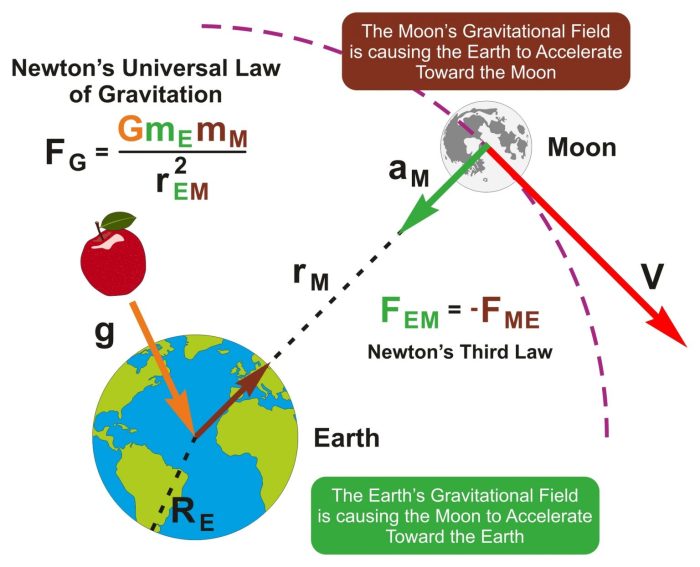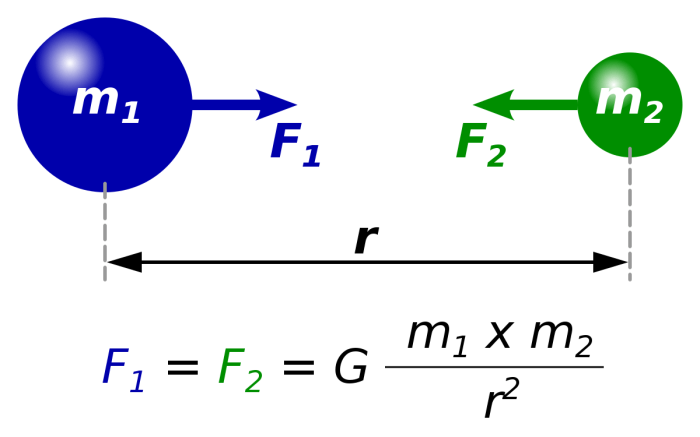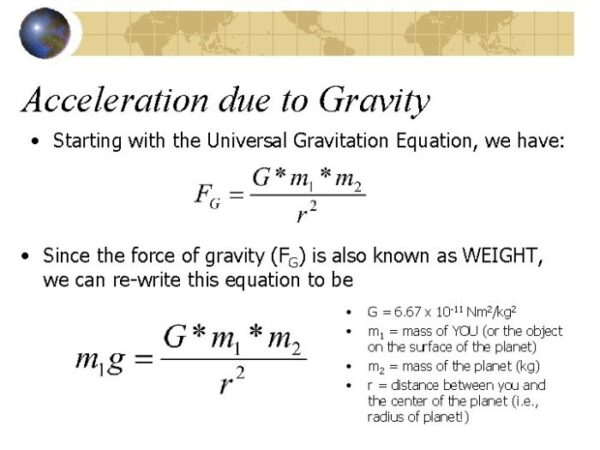
What is gravitational law? It’s the invisible force that holds us to the Earth, keeps the planets in orbit around the sun, and governs the vast expanse of the universe. It’s a force so fundamental that it shapes the very fabric of reality. But understanding gravity goes beyond simply knowing that things fall down. It’s a journey through time, starting with ancient philosophers pondering the mysteries of the cosmos and culminating in modern physicists unraveling the secrets of the universe.
From Newton’s elegant equation describing the attraction between objects to Einstein’s revolutionary theory of general relativity, which paints gravity as a warping of spacetime, our understanding of this fundamental force has evolved dramatically. This exploration delves into the history of gravity, its profound impact on our everyday lives, and the exciting future research that promises to unlock even more of its secrets.
Applications of Gravitational Law

Newton’s law of universal gravitation has profound implications for understanding the cosmos and driving technological advancements. It governs the interactions between objects with mass, shaping the movements of celestial bodies and influencing engineering designs on Earth.
Role of Gravity in Celestial Mechanics
Gravity plays a pivotal role in celestial mechanics, dictating the motions of planets, stars, galaxies, and other celestial objects. It is the force that holds the planets in their orbits around the Sun, keeps the Moon in orbit around the Earth, and governs the formation and evolution of galaxies.
The force of gravity between two objects is directly proportional to the product of their masses and inversely proportional to the square of the distance between their centers.
This law explains why planets move in elliptical orbits around the Sun, with the Sun at one focus of the ellipse. The closer a planet is to the Sun, the stronger the gravitational force, and the faster it moves. Conversely, as a planet moves further away from the Sun, the gravitational force weakens, and its speed decreases.
Influence of Gravity on Orbits
Gravity’s influence extends beyond planetary orbits, impacting the paths of satellites, spacecraft, and even the trajectory of projectiles launched from Earth.
The gravitational force between a satellite and the Earth is what keeps the satellite in orbit.
The orbital velocity of a satellite is determined by its altitude and the Earth’s gravitational pull. A higher altitude requires a lower orbital velocity to maintain a stable orbit. This principle is fundamental in designing satellite orbits for communication, navigation, and Earth observation.
Applications of Gravitational Law in Technology and Engineering, What is gravitational law
Gravitational law has numerous applications in technology and engineering, shaping various fields:
| Application | Description | Example |
|---|---|---|
| Satellite Design | Designing satellite orbits and trajectories, considering gravitational forces and Earth’s rotation. | GPS satellites orbiting at a specific altitude to provide accurate navigation data. |
| Spacecraft Propulsion | Utilizing gravity assists from celestial bodies to accelerate or decelerate spacecraft. | Voyager 1 and 2 spacecraft using gravity assists from Jupiter and Saturn to achieve interstellar travel. |
| Bridge Construction | Calculating the forces acting on bridge structures, considering gravity and wind loads. | Golden Gate Bridge designed to withstand gravitational forces and seismic activity. |
| Building Design | Ensuring structural stability of buildings by considering gravitational forces and wind loads. | Skyscrapers designed with reinforced structures to withstand gravity and wind pressures. |
Einstein’s Theory of General Relativity

Einstein’s theory of general relativity, published in 1915, revolutionized our understanding of gravity. It presented a fundamentally different perspective from Newton’s law of universal gravitation, which had been the dominant explanation for centuries.
Comparison of Newton’s Law and Einstein’s Theory
Newton’s law of universal gravitation describes gravity as a force that attracts any two objects with mass. The strength of this force depends on the masses of the objects and the distance between them. In contrast, Einstein’s theory of general relativity views gravity not as a force, but as a consequence of the curvature of spacetime.
Einstein’s theory proposes that massive objects warp the fabric of spacetime, causing objects to move along curved paths, which we perceive as gravity.
“Gravity is not a force, but a curvature of spacetime.” – Albert Einstein
Limitations of Newton’s Law and Einstein’s Solutions
Newton’s law of universal gravitation is a highly successful theory that accurately describes the motion of objects in most everyday situations. However, it has limitations when dealing with extremely strong gravitational fields or objects moving at very high speeds.
- Newton’s theory fails to explain the precession of Mercury’s orbit. The orbit of Mercury is not perfectly elliptical, but rather precesses (slowly rotates) over time. This precession could not be explained by Newton’s law, but Einstein’s theory of general relativity accurately predicts it.
- Newton’s theory does not account for the bending of light by gravity. Einstein’s theory predicts that light will bend in the presence of a strong gravitational field, a phenomenon that has been observed during solar eclipses.
- Newton’s theory does not explain the expansion of the universe. Einstein’s theory provides a framework for understanding the expansion of the universe, which is driven by a force called dark energy.
Spacetime Curvature and its Impact on Gravity
Einstein’s theory of general relativity describes spacetime as a four-dimensional continuum that is curved by the presence of mass and energy. The curvature of spacetime determines the path that objects take, including light.
“Spacetime tells matter how to move; matter tells spacetime how to curve.” – John Archibald Wheeler
The curvature of spacetime is analogous to the curvature of a stretched sheet. If a heavy object is placed on the sheet, it will cause the sheet to sag, creating a depression. Similarly, a massive object in spacetime causes spacetime to curve.
The curvature of spacetime is responsible for the phenomenon of gravity. For example, the Earth orbits the Sun because the Sun’s mass curves spacetime, causing the Earth to follow a curved path.
Gravitational Waves
Gravitational waves are ripples in the fabric of spacetime caused by the acceleration of massive objects. They travel at the speed of light and carry information about the events that created them.
Discovery of Gravitational Waves
The existence of gravitational waves was predicted by Albert Einstein in 1916 as a consequence of his general theory of relativity. However, it took nearly a century for scientists to develop the technology needed to detect them.
The first direct detection of gravitational waves was achieved in 2015 by the Laser Interferometer Gravitational-Wave Observatory (LIGO). LIGO consists of two detectors, located in Livingston, Louisiana, and Hanford, Washington. Each detector uses a laser beam to measure the distance between two mirrors that are separated by several kilometers. If a gravitational wave passes through the detector, it will slightly change the distance between the mirrors, which can be detected by the laser interferometer.
The gravitational waves detected by LIGO were produced by the merger of two black holes, which occurred about 1.3 billion light-years away. The signal lasted for only a fraction of a second, but it was strong enough to be detected by LIGO.
Significance of Gravitational Waves
The discovery of gravitational waves has revolutionized our understanding of the universe. It has opened up a new window into the cosmos, allowing us to observe events that are otherwise invisible to telescopes.
Gravitational waves provide a unique way to study the most extreme objects in the universe, such as black holes, neutron stars, and supernovae. They can also be used to test the predictions of general relativity and to study the early universe.
- Understanding the Evolution of the Universe: Gravitational waves offer a new way to study the evolution of the universe. They can be used to study the distribution of matter in the early universe, which can help us understand how galaxies and stars formed.
- Exploring the Nature of Gravity: Gravitational waves provide a way to test the predictions of general relativity, which is our current best theory of gravity. By studying the properties of gravitational waves, we can learn more about the nature of gravity and its role in the universe.
- Observing Extreme Events: Gravitational waves can be used to observe events that are otherwise invisible to telescopes, such as the mergers of black holes and neutron stars. This allows us to study these extreme objects in more detail and learn about their properties.
Future Research and Applications: What Is Gravitational Law

The field of gravity is constantly evolving, with ongoing research pushing the boundaries of our understanding and opening up new avenues for technological advancements. This section delves into current research, potential future applications, and the unanswered questions that continue to drive scientific exploration.
Current Research
Researchers are actively investigating various aspects of gravity, including:
- Dark Matter and Dark Energy: Scientists are trying to understand the nature of dark matter and dark energy, which constitute the majority of the universe’s mass and energy but are not directly observable. This research involves developing sophisticated theoretical models and conducting experiments to detect and study these elusive entities.
- Modified Gravity Theories: Alternative theories of gravity are being explored to address discrepancies between Einstein’s theory of general relativity and observations at cosmological scales. These theories aim to modify the gravitational force at large distances, potentially explaining the accelerated expansion of the universe.
- Gravitational Waves: The detection of gravitational waves has opened up a new window into the universe, allowing us to study extreme events like black hole mergers and neutron star collisions. Ongoing research focuses on improving the sensitivity of detectors and analyzing the data to gain insights into the fundamental nature of gravity.
- Quantum Gravity: Unifying quantum mechanics and general relativity remains a major challenge in physics. Researchers are exploring different approaches to develop a theory of quantum gravity, which would describe the behavior of gravity at the smallest scales.
Potential Future Applications
Advances in our understanding of gravity have the potential to revolutionize technology and science in various ways:
- Improved Navigation Systems: Precise measurements of gravity can be used to enhance navigation systems, especially in challenging environments like underground or underwater. This could lead to more accurate GPS systems and improved autonomous vehicle navigation.
- Enhanced Earth Observation: Gravitational measurements can be used to monitor changes in Earth’s mass distribution, providing insights into climate change, water resources, and geological processes. This information can be used for resource management and disaster preparedness.
- New Propulsion Systems: The possibility of manipulating gravity to create new propulsion systems is a topic of ongoing research. If successful, this could revolutionize space travel and enable faster and more efficient interstellar journeys.
- Advanced Materials: Understanding gravity at the quantum level could lead to the development of new materials with unique properties, potentially revolutionizing fields like electronics, medicine, and energy production.
Unanswered Questions and Future Research Directions
Despite significant progress, many questions about gravity remain unanswered, driving future research efforts:
- What is the nature of dark matter and dark energy? This fundamental question continues to puzzle scientists, with various theories and experiments ongoing to uncover their true nature.
- Can we unify quantum mechanics and general relativity? The search for a quantum theory of gravity is a major challenge, with researchers exploring different approaches like string theory and loop quantum gravity.
- Are there other fundamental forces beyond gravity? While we currently know of four fundamental forces, there might be other forces operating at scales beyond our current understanding.
- What is the fate of the universe? Understanding the evolution of the universe and its ultimate fate requires a deeper understanding of gravity and its role in the expansion of space.
- Can we manipulate gravity for technological applications? The possibility of controlling gravity for propulsion systems or other applications is a fascinating area of research with potential for groundbreaking advancements.
Last Point
Gravitational law is not merely a theoretical concept; it’s a force that governs our existence, shaping the universe we inhabit and influencing everything from the tides to the evolution of galaxies. As we continue to probe the mysteries of gravity, we gain a deeper understanding of our place in the cosmos and unlock new possibilities for technology and exploration. The future of gravitational research holds immense potential, promising to reveal even more about the fundamental forces that govern our universe and perhaps even lead to revolutionary discoveries that could change our understanding of reality itself.
Answers to Common Questions
What are the different types of gravity?
While there’s only one fundamental force of gravity, its effects can be observed in different ways, such as the gravitational pull of the Earth, the gravitational attraction between celestial bodies, and the curvature of spacetime. The key difference lies in the scale and intensity of the gravitational force.
Is gravity a constant force?
While gravity is a fundamental force, its strength can vary depending on the mass of objects and the distance between them. For example, the gravitational pull of the Earth is stronger than the pull of the Moon because the Earth has a larger mass. Additionally, gravity weakens with distance, meaning the further away an object is, the weaker the gravitational force it exerts.
What is the relationship between gravity and time?
Einstein’s theory of general relativity posits that gravity and time are intertwined. Stronger gravitational fields cause time to slow down relative to weaker fields. This phenomenon is known as time dilation and has been experimentally verified. For example, time moves slightly slower near the surface of the Earth than it does in outer space.





